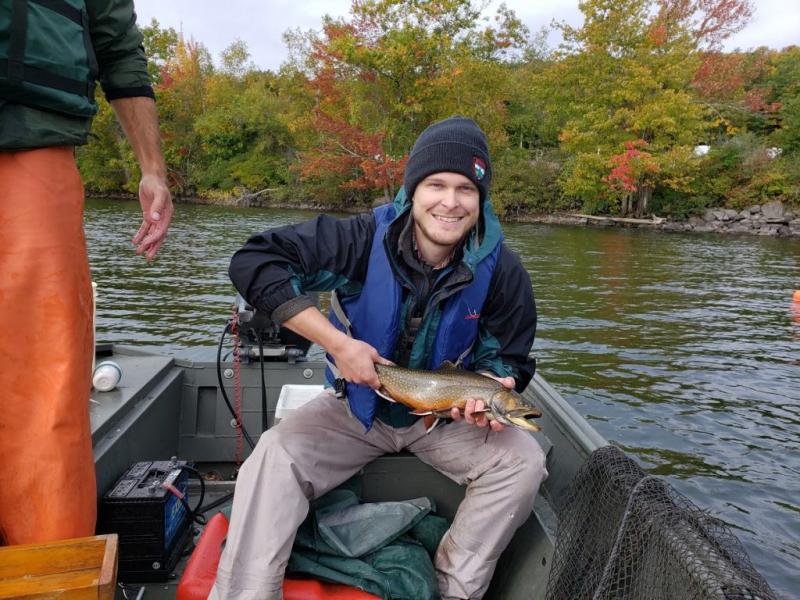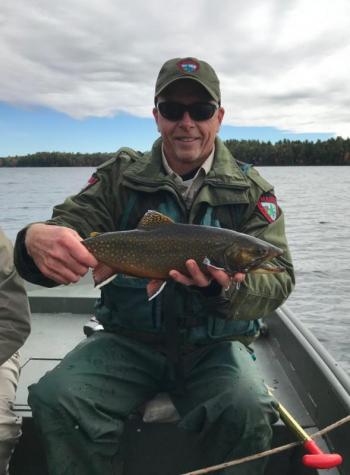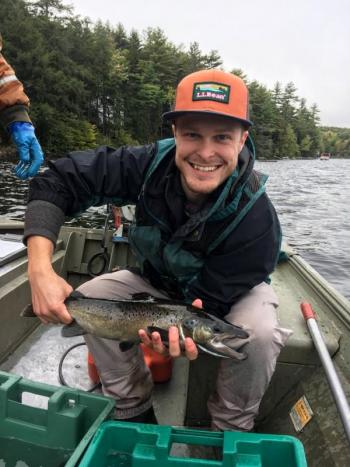The Saint George River flows approximately 50-miles from its headwaters in the town of Liberty to its estuary in Thomaston. Along its route, the St. George has long stretches of flowing riverine habitat and seven lakes encompassing nearly 3,000 acres. The river and its lakes are productive and host a variety of fishes including small- and largemouth bass, chain pickerel, white and yellow perch, white suckers, sunfishes, and newly (and illegally) introduced northern pike.
The Maine Department of Inland Fisheries and Wildlife (MDIFW) stocks hundreds of legal sized brook and brown trout annually at various locations along the river. Due to high summer temperatures, low flow conditions, little groundwater influence, shallow depths, and/or low dissolved oxygen levels, the vast majority of the watershed is unsuitable for year-to-year trout survival and is managed as a put and take fishery. There is however, one very remarkable exception. Lake Saint George.
Lake Saint George lies at the very tip-top of the watershed, and it’s a beauty. The lake covers over 1,000 scenic acres, descends to 70-feet deep, has ample cold water and dissolved oxygen year-round, and has a relatively low density of competitor fishes. It is also teeming with fish calories, as it has a ton of pin-sized rainbow smelt and chaoborus – the delicious larval form of phantom midges. For a large water, the conditions are ideal for the growth and survival of trout and salmon, and that’s highly unusual in central Maine.
Landlocked salmon and brook trout are stocked annually into Lake Saint George. They have been since the late 1930’s. The salmon fishery is consistently top-notch. Stocked at an exceedingly high rate of 1 salmon/acre (1,000 fish annually), anglers routinely catch salmon in the 3-5-lb range. Larger fish are present but not as common. MDIFW fisheries biologists regularly trap net Lake St. George each fall and the results are similar year after year. The 2018 netting was a bit different. Salmon growth (and survival) were comparable to other years, but there were noticeably more fish.
| 2009 | 2012 | 2015 | 2018 | |
| Number of Salmon | 93 | 77 | 81 | 109 |
| Average Length (in) | 18.0 | 18.0 | 18.3 | 18.8 |
| Average Weight (lb) | 2.1 | 2.1 | 2.3 | 2.3 |
Lake Saint George’s brook trout fishery always provides good returns to anglers, and 2-lb fish are readily available. However, the brook trout fishery is very much secondary to the salmon fishery. Brook trout are a bonus. The cherry on top of a successful salmon catch. But, this year’s netting showed markedly different results. Like salmon, brook trout growth (and survival) were comparable to other years, but overall brook trout numbers were ridiculously higher. Biologists were surprisingly giddy with all the brook trout biomass in the nets.
| 2009 | 2012 | 2015 | 2018 | |
| Number of Brook Trout | 6 | 0 | 4 | 62 |
| Average Length (in) | 14.2 | – | 14.4 | 14.1 |
| Average Weight (lb) | 1.1 | – | 1.3 | 1.2 |
We aren’t certain the precise reason(s) for the newly emerged army of brook trout. We believe it is a combination of some recent changes in stocking size and numbers. Or, maybe it has something to do with an increase in chaoborus productivity or smelt spawning success. We really don’t know for sure. What we do know is that Lake Saint George is currently bursting at the seams with some beautiful brook trout and salmon.
Regional fisheries biologists are both happy and concerned with the high number of salmonids swimming freely in Lake St. George.
We’re happy because there’s currently a ton of legal trout and salmon at large for Maine anglers.
We’re concerned because these fish are large and hungry and may impact the lake’s forage base resulting in a less healthy salmon population.
It’s all about balance. In order to maintain a healthy equilibrium between predator (i.e. trout and salmon) and prey (i.e. smelt and chaoborus), Lake St. George requires some immediate prey harvest. That’s where you come in.
If you haven’t fished Lake St. George in the past, this is the winter you’ll want to give it a go. We’re quite certain you won’t be disappointed.
Wes Ashe is a fisheries biologist with the Maine Dept. of Inland Fisheries and Wildlife





























